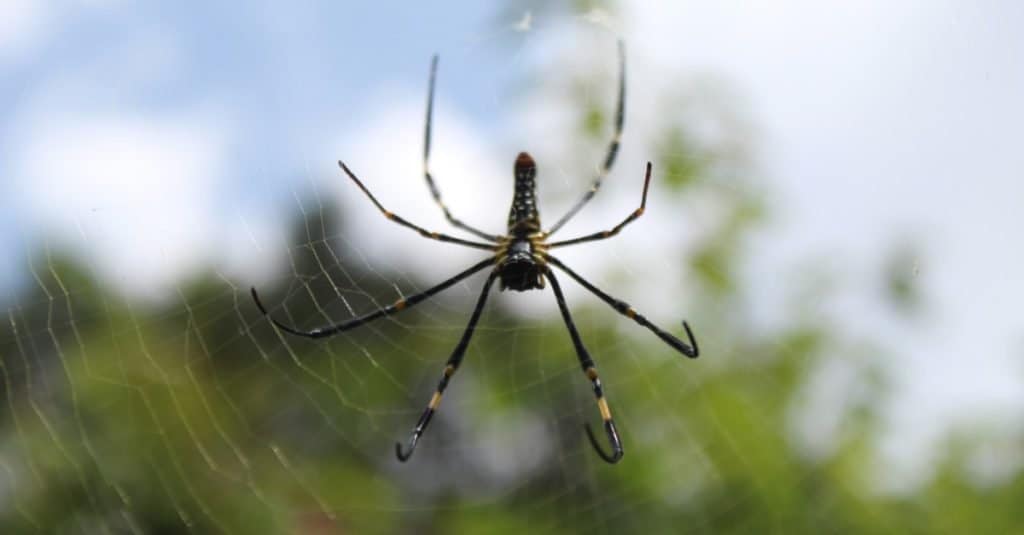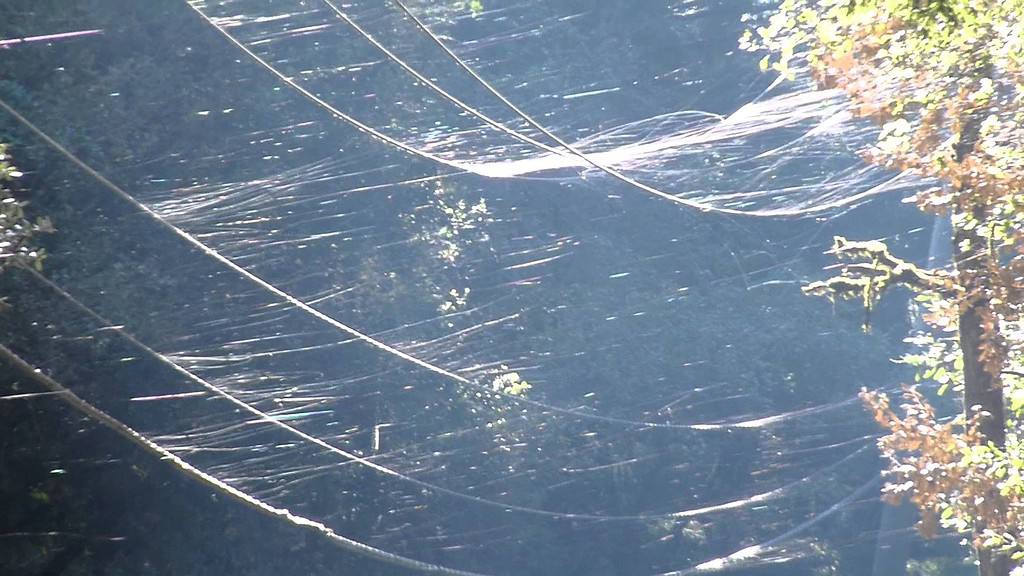Flying spiders?
Yes, you read that right. If you have arachnophobia – a fear of spiders – flying spiders may sound like something out of a nightmare. Social media influencers have tried to convince viewers that flying spiders will soon be invading their backyards.
What are flying spiders? Are flying spiders real? Where do flying spiders live? Is there a spider with wings?
What Are Flying Spiders?
Can a spider with wings exist?
The simple answer is no, but there are flying spiders. But they’re not what Twitter and Facebook may have led you to believe.
The so-called flying spider, also called the gray cross spider or bridge spider, is scientifically classified as Larinioides sclopetarius. It is a large orb-weaver spider, meaning it spins a round web. It was first discovered in 1757.
What Do Flying Spiders Look Like?
Flying spiders are mostly brown or grey in color with dark and light markings on the abdomen. The legs are banded with brown and cream. The abdomen is large and round, while the cephalothorax or head is small in comparison.
A flying spider can reach a staggering 3 inches long but is usually smaller, and its webs are up to 70 cm in diameter. Adult spiders weigh less than 2 milligrams, with females being nearly twice as large as males. The males typically do not spin their own webs but live in the webs of females in order to steal the prey the females caught.

.
©gowrishankar R/Shutterstock.com
Where Do Flying Spiders Live?
Flying spiders have a Holarctic distribution, which means they live in habitats throughout the northern continents – North America, Europe, and Asia. In North America, flying spiders are common near the Great Lakes, but can be found throughout the United States.
They are attracted to man-made objects such as buildings and bridges. This is where they get the common name “bridge spider.” They are also commonly found near water, including on boats. They have traveled via boat to many isolated islands.
Flying spider webs are often clustered around light fixtures. Lights attract prey insects, which in turn attract the spiders.
In some cities, up to 100 flying spiders may be found in a single square meter. They hide during the day and wait for prey at the center of their webs during the night. They can be found during the warmer months, from early spring through November. In America, they are most commonly seen from May to August.
In the city of Chicago, USA, residents of some high-rise buildings have been asked not to open their windows during the month of May. This is because the spiders are known to migrate via ballooning at that time. This natural cycle has been called “the Chicago Phenomenon.”
Why Are They Called Flying Spiders?
Contrary to popular belief, flying spiders are not mutant arachnids with wings. There are no spiders that have wings or that fly in the traditional sense of the word. Their name comes from a form of locomotion called ballooning. The spider releases threads of silk into the wind, using these as a “balloon” to carry the spider through the air.
The flying spider is not the only species to exhibit this behavior. You might remember the spiderlings in the classic children’s book and film Charlotte’s Web flying away on silken strands. Many crab spiders do this as well.
Do flying spiders fly around all the time? No, they do not. They spend their days hiding and their nights guarding their webs, waiting to eat any insects they catch. The spiders balloon or fly only when they need to travel to a new feeding ground. This may happen when insects become scarce in an area or when there is a lot of competition from other spiders.
Would a flying spider land on you? Probably not. The spiders are blown by the wind; they cannot control their flight. If one were to land on you, it would be a simple accident. It would likely not stay on you long. Rather, it would drop to the ground or take flight once again, still searching for an ideal home.
Are Flying Spiders Venomous (Poisonous)?
All spiders have venom which they use to immobilize their prey. Flying spiders, however, are not likely to bite humans, even when they exist in large numbers near human habitations.
One of the main facts about flying spiders is that they have venom, however, it is not poisonous at all. If they were to bite a human, it would not be lethal. It would even heal fairly quickly. Whenever these spiders feel danger or search for prey, they will bite, otherwise, they tend to be docile.
In short, flying spiders are not dangerous to people.
The spiders may bite if they feel threatened, for instance, if you disturb their webs or try to hold them in your hand. If you are bitten, their venom is less powerful than that of a honey bee, sometimes compared to a mosquito bite. The bites heal quickly and usually do not require medical attention.
Is There Going to Be a Flying Spider Invasion?
The simple answer to this question is no, there is not going to be an invasion of flying spiders. Flying spiders have lived in the Northern Hemisphere for untold centuries. If you happen to see a flying spider where you live, it and its ancestors have likely been there all along.
If you live in Chicago or another area that sees the “spider phenomenon,” the occurrence of spiders taking to the wind will last only a short period of time. Even when the spiders land, they will simply build webs near outdoor lights or on window sills. They will not invade your home as in a horror movie.
Flying spiders are also territorial; they are not social spiders. They may build webs beside one another, but females do not allow other females to enter their webs. This territoriality limits how many flying spiders may inhabit an area.
There are also natural predators that help control the flying spider population. A scuttlefly called Phalacrotophora epeirae feeds on the eggs of the flying spider. In southern Europe, a hunting wasp called Trypoxylon attenuatum preys on adult spiders. It paralyzes the spider, brings it back to its nest, and lays an egg inside the spider’s body. The wasp larvae then feed on the spider after hatching.

©Ademortuus/Shutterstock.com
What Are Some Interesting Facts About Flying Spiders?
Flying spiders are interesting creatures. They carry venom but are not poisonous. If they were to bite a human, the bite would not be lethal and would heal fairly quickly compared to other spider species. Flying spiders are harmless to humans as they are not known to be aggressive or fearful of people.
Some other cool facts about flying spiders include:
- Each flying spider lives about one and a half years. In that time, a female spider can produce 15 sacs of eggs. Female spiders may eat the male spiders if other insect prey is scarce.
- Flying spiders are more active than some other spiders and they like to explore new environments. This may have led to them becoming so common in cities spread across a large area of the world.
- Male flying spiders can biologically change into females if there are not enough females in the population. This is known as protandry.
How Far Can Flying Spiders Fly?

According to researchers at the University of Bristol, spiders can sense the electric field in the earth and use the negative charge of their silk to repel the negative charge of the earth.
©Little Grove Farms, CC BY 3.0 – License
Flying spiders, using the practice of ballooning, are able to ‘fly’ extremely long distances. The strands of silk that they shoot into the air are able to carry them for hundreds of miles. For the longest time, it was unknown how they were able to have their silk strands carry them at all but the reason may have finally been found. According to researchers at the University of Bristol, spiders can sense the electric field in the earth and use the negative charge of their silk to repel the negative charge of the earth.
These researchers were able to test their hypothesis by placing spiders in a closed container and introducing them to an artificial electric field which is when they began to see a reaction. The tiny sensory hairs on the spiders’ feet became disarranged, which is then when their abdomens started to lift and they took off. As soon as the artificial electric field was shut down, the spiders dropped to the ground.
Other Animals that Practice Protandry
Flying spiders aren’t the only animals on the planet that can biologically transform from male to female. Other types include insects like the Western cicada killer wasp. Several kinds of fish in the following categories can also possess this interesting ability: crustaceans, mollusks, anemonefish, and fish from the following families: Clupeiformes, Siluriformes, Stomiiformes. No terrestrial vertebrates can practice protandry.
Conclusion
Flying spiders are nothing to be afraid of. They exhibit marvelous behaviors that make them unique in the animal kingdom. If you see a flying spider or a group of them as in the “Chicago Phenomenon,” take a good look, because there is no reason to be scared.
The photo featured at the top of this post is © Lalachangphotographer/Shutterstock.com
Thank you for reading! Have some feedback for us? Contact the AZ Animals editorial team.






